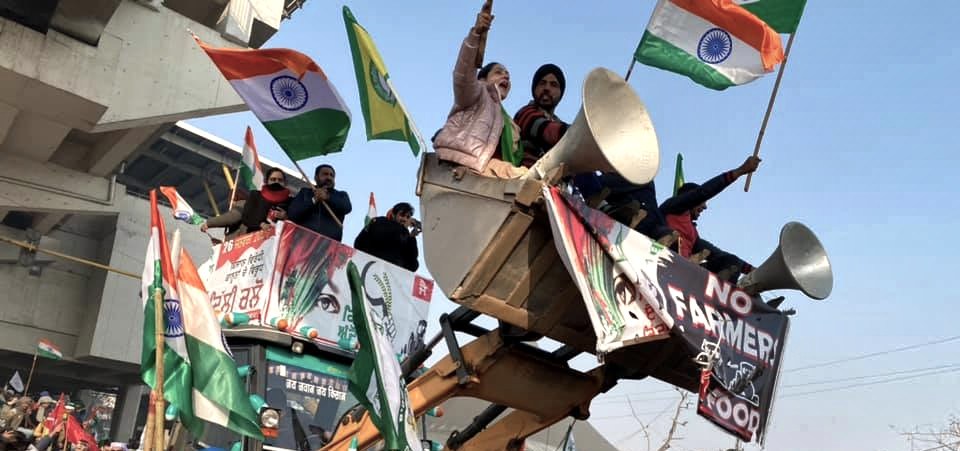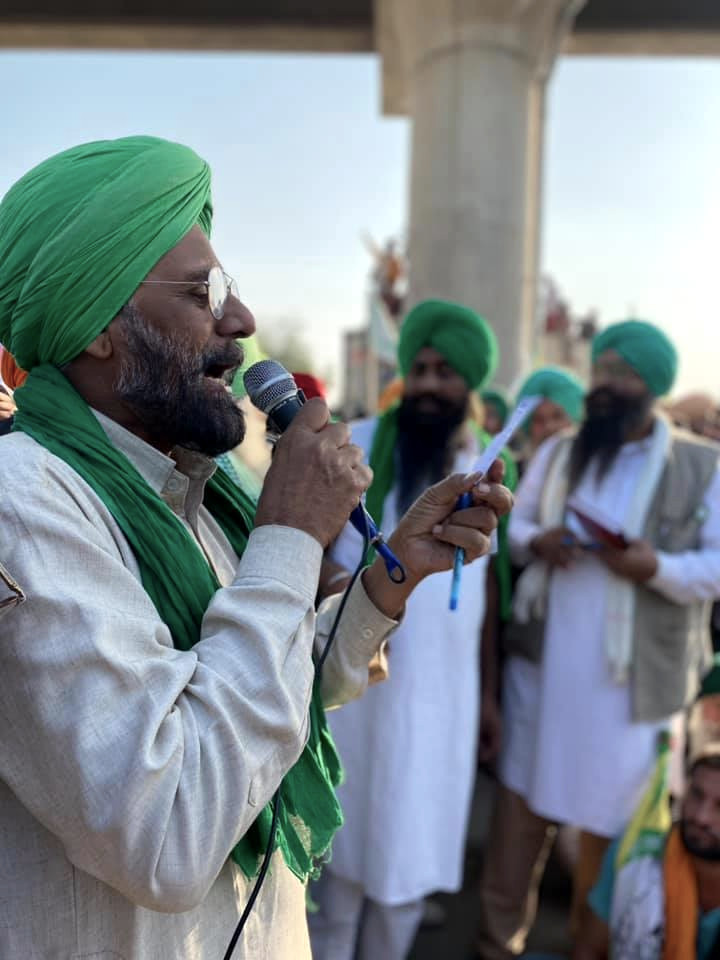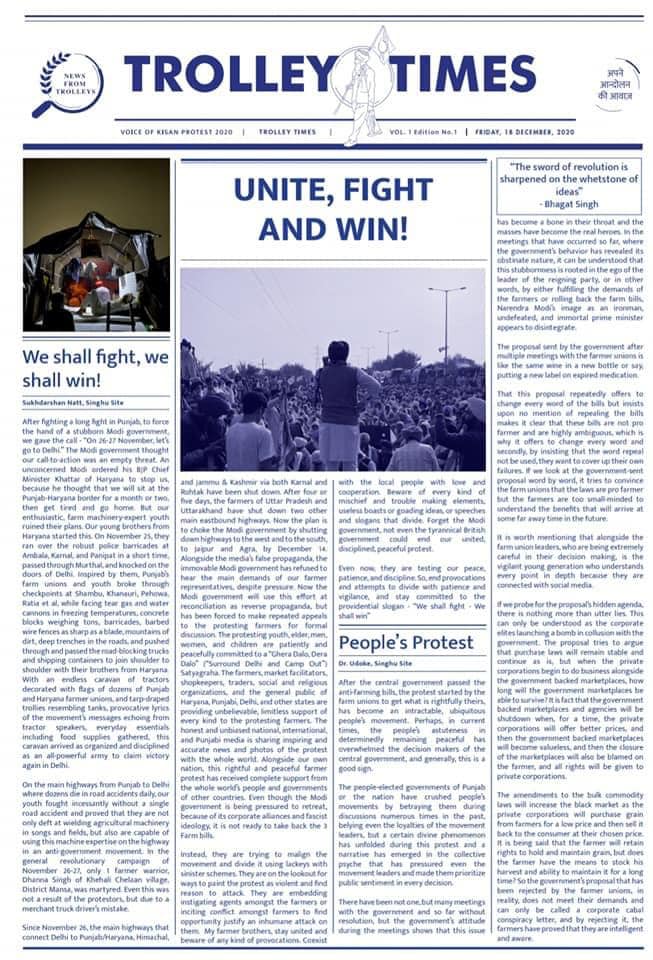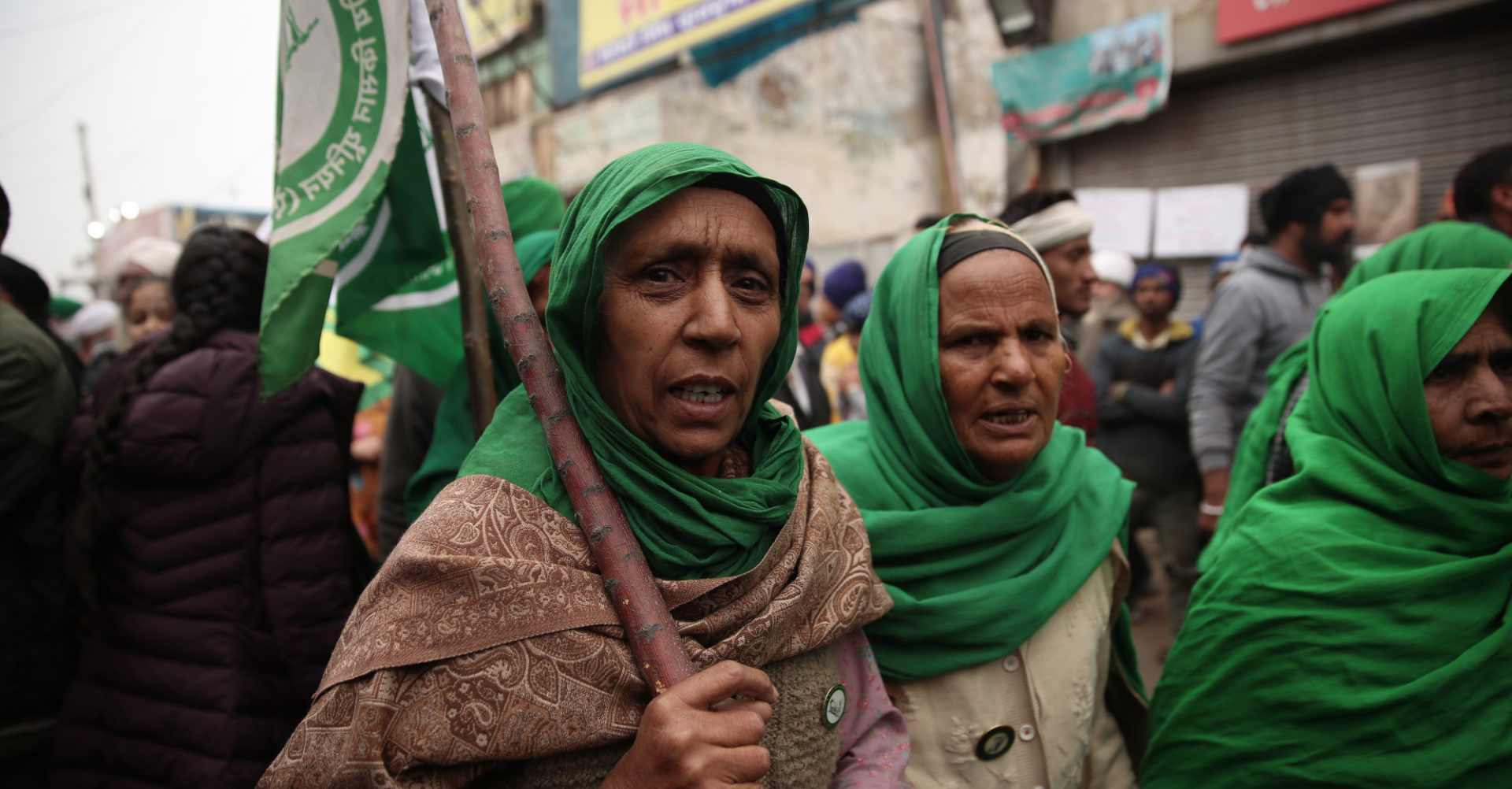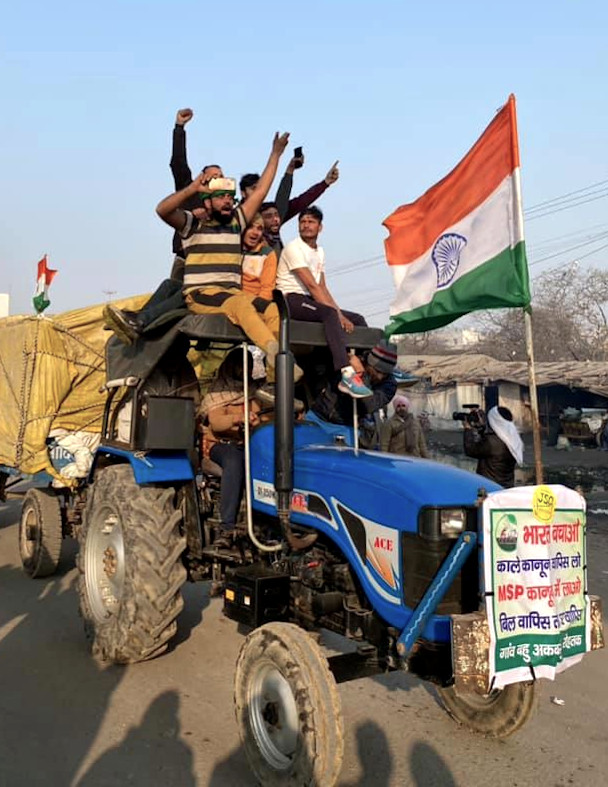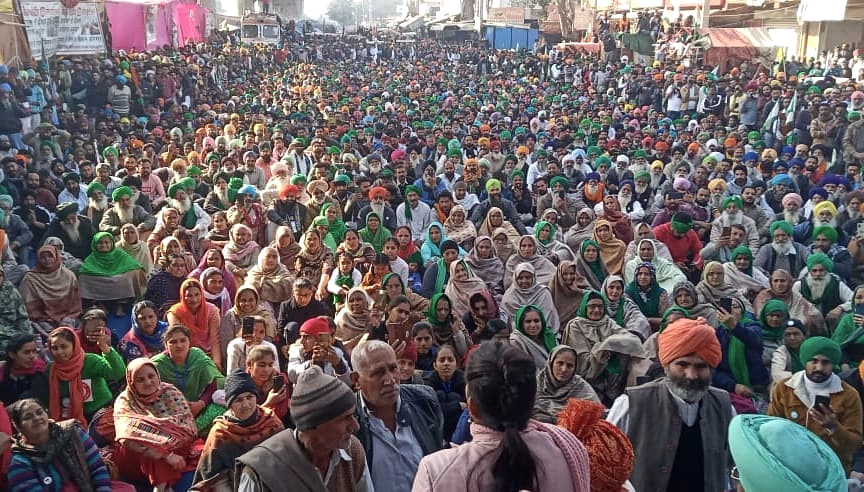Farmers in the early days of the protest in Amritsar, Punjab, India. November 27, 2020 Photo: Sanjeev Syal / Shutterstock.com
India’s farmers’ protests: “This is history in the making”
- February 5, 2021
People & Protest
Amidst the months-long, farmer-led protests on the outskirts of Delhi, the foundations of a more democratic and anti-corporate India are being built.
- Authors
On January 26, 2021, India observed its 71st Republic Day under historically unprecedented circumstances. On an occasion meant to commemorate the adoption of the Indian Constitution, two fiercely antagonistic visions of the country locked horns with each other in the capital of Delhi.
On the Rajpath ceremonial boulevard in the heart of Delhi, Prime Minister Narendra Modi and the ruling Bharatiya Janata Party (BJP)’s homegrown Hindu nationalist proto-fascism was on full display. It was no coincidence, for example, that the winner of the Republic Day Parade’s tableaux competition was the state of Uttar Pradesh, whose float celebrated the demolition of the Babri Mosque in 1992 and its impending replacement by a Hindu temple — a blood-soaked, decades-long travesty that has dovetailed with the rapid proliferation of the Hindu right.
In other parts of Delhi, however, a rather different spectacle was unfolding, as tens of thousands of farmers, primarily from the neighboring states of Punjab and Haryana, took over the streets of the city with their tractors.
For the past two months, hundreds of thousands of farmers have camped out on the outskirts of Delhi to protest three recently passed, transparently pro-corporate agricultural laws that stand to devastate their livelihoods. Coordinated by the Samyuta Kisan Morcha (United Farmers’ Front or SKM), the participants in the January 26 rally attempted to proceed along three pre-planned routes, but came up against police barricade after barricade. In the most explosive moment of the day, a section of the tractor parade broke away and entered the Red Fort, an iconic historical landmark in the heart of Delhi. Amidst gunfire, teargas, and lathi (baton) charges by state authorities, as well as a widely condemned internet shutdown, the protesters raised their own flags over a location famous for the prime minister’s hoisting of the Indian tricolor on Independence Day.
Notwithstanding predictable condemnations from India’s “law and order” liberals and leftists, the storming of the Red Fort and the Indian state’s hyper-repressive response exemplify how the protesting farmers have rocked Modi and the BJP to their core. They pose the most fundamental threat to the BJP’s neoliberal Hindu chauvinist agenda since Modi first came to power in 2014.
India’s Descent into Neoliberal Hindu Nationalist Authoritarianism
While the scale of the current resistance is unprecedented, the government’s targeting of vulnerable populations is not. Farmers are but the latest to appear in the cross hairs of the Modi government. Immediately after receiving a renewed mandate in India’s 2019 general election, Modi and the BJP stripped the majority Muslim region of Kashmir of its statehood, while simultaneously intensifying its brutal occupation by Indian military and paramilitary forces. This move came on the heels of the BJP-controlled northeastern state of Assam’s publication of a National Register of Citizens, which deliberately targeted Bengali-speaking Muslims, who are automatically presumed to be “illegal immigrants,” for detention. Finally, in December of 2019, India’s Parliament passed the Citizenship Amendment Act, which grants citizenship solely to non-Muslim refugees from Afghanistan, Bangladesh and Pakistan and could set the stage for rendering up to 200 million Indian Muslims stateless.
These measures — and the brutal repression of the mass protests that followed in their wake — demonstrate the Modi regime’s determination to lay the foundations for the ultimate goal of a Hindu supremacist ethnostate upheld by the Rashtriya Swayamsevak Sangh (National Volunteer Organization or RSS for short), the engine of the Hindu nationalist machine that was directly inspired by the Hitler Youth and Mussolini’s Black Brigades.
The social and cultural dimensions of the Hindu right’s authoritarianism underwrite its unabashedly neoliberal economic agenda. Modi rose to national prominence by implementing the “Gujarat Model” of politics in his home state, which essentially promotes economic growth by any and all means necessary, including extreme violence. Modi’s ruthlessness earned him the support of India’s foremost corporate dynasties, from the Tatas and the Ambanis to the Adanis. In exchange for bankrolling his political ascendancy, Modi has rewarded his corporate backers handsomely throughout his time in office: the annexation of Kashmir, for instance, has created a prime investment opportunity for Reliance Industries, the gargantuan conglomerate owned by India’s richest man, Mukesh Ambani.
In September of 2020, Modi and the BJP made perhaps their most profound corporate overture to date when they pushed through three agricultural bills that stand to “virtually kill the rights and entitlements of the agricultural population,” according to the Centre of Indian Trade Unions. As Peoples Dispatch explains, the Farmers’ Produce Trade and Commerce (Promotion and Facilitation) Bill, 2020 would prevent farmers from getting guaranteed prices for their crops by forcing them into an unregulated market space known as a “trade area.” Furthermore, the Essential Commodities Bill, 2020 would remove various items such as cereals, pulses, edible oils, onions and potatoes from the list of essential commodities, allowing large corporations to hoard these necessities.
Finally, the Farmers (Empowerment and Protection) Agreement of Price Assurance and Farm Services Bill, 2020 would allow for contract farming in India, which, given that 86 percent of India’s farmers own less than two hectares of land, would further shift the balance of agricultural power in favor of large corporations. Ambani’s Reliance Industries and the Adani Group of fellow billionaire industrialist Gautam Adani rank among the foremost prospective corporate beneficiaries of these bills.
Lessons from the front line
Why have the aforementioned farm laws brought millions of protesters into the streets of Delhi and many other parts of India? How have farmers sustained their protest for over two months? How have the Indian and international media covered the farmers’ actions, and how have movement participants sought to combat misconceptions often propagated by this coverage? What are the deeper roots of the ongoing struggle? What do these protests mean for India and the wider world?
Seeking answers to these pressing questions, I spoke to Mukesh Kulriya, a third-year PhD student at the University of California, Los Angeles’ School of Music who has been on the front-lines of the farmer-led mobilization at the borders of Delhi since it first began. Mukesh is a longtime member of the All India Students Association (AISA), the collegiate wing of the Communist Party of India (Marxist-Leninist) Liberation.
Sarang Narasimhaiah: Could you describe the basis for the ongoing political action staged by farmers from Punjab, Haryana and other surrounding areas of Delhi, as well as so many other parts of the country?
Mukesh Kulriya: The immediate cause for this protest is that the Modi government passed three agricultural bills in a very undemocratic manner: these bills became laws under the cover of the COVID-19 pandemic, when the Indian Parliament was not even in session. The way the bills were passed was also unconstitutional: agriculture is a state matter in India, not a federal one, so how can the federal government rule on it? Moreover, even if you take a cursory look at these bills, you can see that they are totally pro-market. We need to remember that this government also carried out labor reforms that snatched away essential labor rights from organized sector workers, allowing them to be hired and fired as their employers please and placing their right to unionization under threat. The largest working population of the country — the workers and farmers who make up 80-90 percent of India’s workforce — have been hammered by both these sets of bills.
There was a lot of uproar when these laws were first proposed, and people quickly started to mobilize against them in Punjab. For a couple of months, they were organizing at the village level, but by the end of August and early September, protests started to erupt in cities across Punjab. What distinguished these protests was that they recognized the laws as a neoliberal attack on agriculture, and so they began to target the corporations responsible. The Adanis and Ambanis run the largest conglomerates in India: they are heavily invested in the privatization of agriculture and also very close to the current regime. As such, the slogans raised at the protests have opposed Prime Minister Modi but have also declared that he is nothing but a puppet in the hands of these corporations. This is not some academic writing a paper that criticizes neoliberalization: rather, corporations are being named and shamed by the common people. Farmers have shut down virtually all stores owned by the Adanis and Ambanis, hitting these corporations where it hurts. They have also taken out toll plazas across the state and refused to pay their toll taxes. In these ways, a mass popular movement has emerged addressing the questions of livelihood, land and labor: the classic issues of India’s feudal system [which continue to indelibly shape its capitalist present].
Corporations are being named and shamed by the common people.
On November 26, 2020, Indian laborers opposed to the above-mentioned labor reforms as well as the farm bills called for an all-India strike, and this was hugely successful. 250 million workers participated in that strike [making it the largest labor action in recorded human history]. On that same day, farmers from Punjab decided that they should march to Delhi. When they reached the borders of the city, they were stopped by the police and other government forces, who dug 15-meter wide holes in the road, put up ten layers of barricades and barbed wire, and used tear gas and lathi charges against the farmers.
When videos of these attacks showing the brutality of this government started to circulate, many people were moved to take action. The next day, more people from Punjab and Haryana started coming to the borders of Delhi, and the state couldn’t do anything to stop them. The farmers and their supporters wanted to occupy a central space in Delhi, but the government tried to force them into a remote corner of the city; the protesters refused to use this site and decided to block the city instead. Incredibly, by now, the capital of India has been blocked by protesters for almost two months. Some of these protests are almost 15 kilometers long; you can see one to two hundred thousand people at one protest site alone.
This protest is significant to no small extent because Punjab is one of India’s more well-off states, largely due to agriculture. Punjab has been suffering as a result of India’s agricultural crisis in a very different way from the rest of the country. Punjab was basically a laboratory for the Green Revolution in India, along with Haryana and Western Uttar Pradesh. This makes it the only agricultural belt in the country where small farmers have a little money. However, because of pesticides and other chemicals used in industrial farming, this area has also become a cancer belt. There is actually a train that goes from Punjab toward my hometown in Rajasthan which is known as the “Cancer Express.” People see the money that agriculture brought to Punjab, but not the cancer, the huge indebtedness and the institutionalized drug racket that has been very active in the state.
Punjab has a long revolutionary history; the powers that be know that this state could be dangerous to them, and so they have sought to undermine its people while pocketing the wealth it generates. For that reason, it’s incredible to see young people who have been demonized as drug addicts come to the protest to show that they can be much more. They aspire for a better life that does not involve going abroad but rather fighting for better conditions in their homeland. You’re seeing the revitalization of a radical political consciousness in Punjab, in terms of poetry, in terms of music, in terms of the whole culture of organizing.
It is important to recognize that this is a mass movement by people who are not the poorest of the poor in the sense that the state believes. The state is used to looking at the farmer as someone who is worn and torn, who is very poor, who is very hungry, who is spreading their arms towards the state for some sort of help. However, these farmers, who are suffering even though they are relatively well-off, are very much challenging that image.
What does the day-to-day business of organizing the protests look like? And why have these protests been so effective?
The protest sites are basically temporary cities: you can get everything you need here. The protesters are running langars [traditional Sikh food services], medical services and many other kinds of services by themselves: they take shifts, and they do the monetary and physical labor to provide these services. People have realized that, when you fight against one kind of oppression, you also come to see other kinds of oppression that you perpetuate, and this realization has shaped the sociocultural structure of the protests: men are now cooking food, and women are leading political actions. The protests have been led by elders who have experience with mass movements, and they are striving to share this experience with younger generations like mine, who are seeing something like this for the first time in our lives; we are shouldering the logistics of the movement, learning as we go. We are learning that you can only save democracy if you take to the streets; you cannot expect democracy to work if you are sitting in your living room.
Many of the protesters are from rural agrarian communities, and so their day starts very early — around 5:00 or 5:30 am. They start cooking food, have breakfast and then head to their protest site’s central stage at 9:00 or 9:30 am. Every day, around 10 to 20 people go on a 24-hour hunger strike across all protest sites. In the daytime, people come from different parts of the country — or the world — to give speeches and show their solidarity.
We are learning that you can only save democracy if you take to the streets; you cannot expect democracy to work if you are sitting in your living room.
Every day, there is a meeting of the All India Kisan [Farmer] Coordination Committee, which is comprised of 32 different organizations. This movement does not have a single leader but rather a collective leadership. That’s also why it is so strong: “ordinary” people are so invested in the movement that no one has been able to hijack it. The Coordination Committee itself has been very clear that this is a people’s movement: if its leaders make any wrong decisions or unjustifiable compromises, they know that they will be thrown out the very same day.
The protesters are also saying that they are not in a hurry. They want the government to scrap the three laws, and they won’t settle for anything less. The kind of patience that they have is not conducive to settlement: they know that this is a long, drawn-out fight, and they are prepared to stay here for at least six months. The protesters are thus energetic but they’re also at ease, in a way; they know that they can’t be agitated and sloganeering all the time.
How have you and your AISA comrades endeavored to support the protesters?
Libraries are a key part of the temporary towns established by the protests. AISA is running an initiative known as the Shaheed Bhagat Singh Library at four protest sites. We open our library in the morning and a lot of people, from young students to older people, stop by and engage us.
We also started a newsletter, The Trolley Times. This newsletter was spurred at the initiative of a handful of independent individuals, and it is not associated with any single political organization. We realized that all recent social movements have relied almost solely on social media. Younger protesters had actually stopped considering fields of engagement beyond social media. As I said earlier, the people who are the backbone of these protests came to Delhi from their villages two months ago. They have been keeping their grounds while living about 10 kilometers away from their nearest stage; they know their responsibilities to the protests, and they are not looking for the limelight. Concerned that no one would talk to these people — or even acknowledge their presence — we wanted to ensure that they have a very clear sense of what is happening in the movement. These are older people, and so they are more likely to read newspapers and newsletters.
From the very first day that we published The Trolley Times, we got an amazing response. The vast majority of the Indian media is pro-corporate and owned by the same companies that want to privatize agriculture; these media are also pro-state, and so they demonize protesters with their propaganda. People realized that, to take ownership of this movement, they need their own voice. That’s what The Trolley Times aims to be. Becoming hugely popular within a day or two, The Trolley Times got a lot of media coverage, and it actually set a trend: now, there are three to four newsletters made by and for the movement. The Trolley Times gives a platform to first-time protesters, young protesters, elderly protesters and single women protesters. To a barber who came here to give massages to tired protesters. These are the small but important stories that we are able to cover. We have published eight editions so far; most of us are working over the phone — partly because we have no proper internet access here — and we are typing and editing the content for the newsletter as it is reported to us.
The Trolley Times gives a platform to first-time protesters, young protesters, elderly protesters and single women protesters.
We started another initiative called “Trolley Talkies,” which involves showing films about the farmers’ crisis as well as revolutionary movies about the Indian Independence Movement and other movements across the world. We show movies to energize people by entertaining them and educating them about the farm bills: we make connections across time and space by showing how neoliberalism builds upon the foundation established by British colonialism. First-time protesters in particular need to understand the historical nature of these protests: how are they linked to policies that were introduced in India in the 1970s, ’80s and ’90s? How were these policies forced upon the people, and what are their implications? We have undertaken these and other artistic initiatives with the understanding that resistance is creative; you can also see this in the many songs that the protesters have composed and all of the artists from Punjab who have come out to support the protests. We need to employ all kinds of art forms to reach the masses.
Throughout our work, we’re trying to make intersectional connections across different issues and policies. When you oppose the privatization of agriculture, you must also oppose the privatization of education, healthcare and everything else. You can’t be selective: neoliberalism is a policy framework and mindset that’s basically doing the same thing to students, to farmers, to workers, to everyone. It has to be fought tooth and nail as a singular entity.
I’m sure you have many options to pick from, but who are some of the most interesting persons you have met in your time out there?
The most interesting person I have met is this 17-year-old girl who came to the protest on her own. Her parents have a small patch of land, and she saw that, if these farm bills stand, her land will not be safe. She won’t be able to continue her education or make a career for herself, thus sacrificing her independence. And so she took a train to Delhi and stayed here for a long time, participating in the protest and looking after the library.
Her case shows how the protesters understand the gravity of this situation: they know that this is a do-or-die scenario. It also shows how this movement is not just about agencies like Khalsa Aid [an international humanitarian NGO based on Sikh principles] that are setting up big stalls to help people. This is also a movement in which people are coming out and helping at an individual level. You can find a lot of other similarly powerful stories here: whole families have come to the protest and haven’t left for the past two months. Young students are taking their exams here. Young professionals have left their jobs to be here. You see activists coming from all spheres of life: this is a mass movement, not a student movement, which tends to draw upon a very select population of the country. You can find an 18-year-old truck driver protesting alongside a PhD student like me. These kinds of social connections would have been impossible to imagine in normal times. This movement is basically a school of democracy: you learn that this is the people in all its variety, and you need to figure out how to work with them. A kind of professionalization is taking place among all the activists here, whether this involves media work, domestic labor, or any other tasks we undertake.
You have already talked about how the pro-state and pro-corporate media has been covering and, in key respects, not covering these protests. Would you like to address any specific misconceptions intentionally or unintentionally propagated by the Indian and international media, be it mainstream, independent, or even progressive or leftist?
How much should we expect of the Indian media? Two companies own 80 percent of the media. Reliance alone owns 36 news channels. They basically peddle lies day and night. They show a 10-year-old video as evidence that the protesters are Khalistani separatists [demanding a Sikh homeland]. That’s why, when a lot of media come here, their reporters don’t show their name tags and even cover up the tags on their mics; they know that they have no credibility here.I think the biggest misconceptions about these protests is that these are rich people protesting, that they are motivated by electoral politics, and, of course, that foreign powers are behind these protests and that they are “anti-national” and anti-constitutional. One thing is clear: all protesters are bad protesters to this government. Students are anti-national, women are anti-national, Dalits are anti-national, Muslims are anti-national, workers are anti-national, farmers are anti-national. This is a majoritarian government for whom only a minority of people are actually citizens: the rest are all anti-nationals. This narrative is not only promoted by the government: it has been repeated by the pro-state media, and it has seeped into the international media’s coverage as well.
This movement is basically a school of democracy: you learn that this is the people in all their variety, and you need to figure out how to work with them.
Another misconception is that these protesters do not know about the law. The government and the pro-corporate, pro-state media are saying that the privatization of agriculture is good because it promotes competition. Competition among whom?
One more major misconception is that this protest only involves the Sikh farmers of Punjab. The government and mainstream media are trying to give the protests a religious angle, because that’s very easy, right? When minorities go against the majority and the majoritarian state, they are terrorists, right? We are trying to counter the idea that these are just some Punjabi Sikh men protesting against the Indian state through all our initiatives and activities. Protests are happening in virtually every part of India: Punjab, Haryana, Rajasthan, Gujarat, Maharashtra, Kerala, Tamil Nadu, Bihar, Uttar Pradesh, Orissa, West Bengal, Chhattisgarh, Uttarakhand, Himachal Pradesh, and even Kashmir. Just because all of these protesters are not at the Delhi border does not mean that they are not protesting.
We have also said again and again that we are here to peacefully protest and so, if anything goes wrong, the state is responsible. If anything unruly happens, we make sure we record it, so that we can provide those recordings to any media we contact and say, “Look at what we have witnessed.” We know that, when it comes to violence, no one can beat the state: it is the ultimate agent of violence, sometimes through the law and sometimes more directly through the police.
Why should people of conscience, especially progressives and leftists, across the world care about these protests and the issues that the farmers are addressing? How are these issues and the corresponding protests globally interconnected? And how have people of conscience from outside of India been showing meaningful solidarity with the farmers and how can they continue to do so?
Solidarity protests have been happening across the world; the mass support that these protests have received extends to the South Asian diaspora. The Trolley Times has further been translated into several languages and distributed not only in different parts of India but in Canada, Australia, New Zealand and the United States as well.
At a foundational level, I’d desist from saying that this is a “farmers’ protest.” I’d only say that farmers are leading the protest. India is a poor country with a few rich people. Between 70 and 80 percent of Indians suffer from malnutrition. The Essential Commodities Act allows private businessmen to hoard essential items such as food grains and oil. The de-regularization of prices allows for black markets in such a way that you might end up with godowns [warehouses] full of food grains and a huge population at threat of starvation. In that sense, these laws are an attack not just on farmers but on everyone who eats. This should be a concern for everyone across the world who believes that every human being has a right to eat.
India also accounts for one-sixth of the world’s population. These laws stand to affect the food security, nutrition and overall health and safety of a huge number of people, which in itself should make them everyone’s concern.
Privatization is also a global phenomenon. Raise your voice against privatization in your home country. We don’t just want you to stand with us: we want you to stand up for yourself. These multinational companies have to be defeated not only in India, but also Africa, America, Australia, Europe — everywhere. Everyone is on their radar, and, to counter multinational companies, we need multinational protest.
In addition, these laws rob farmers on the one hand and consumers on the other. I am not here just to support farmers; I am also here as a consumer. I know that I will have to pay so much more to have a basic meal if these laws are implemented. Why should consumers pay so much for food when farmers aren’t even getting a fair price for their agricultural products?
What are the most significant challenges that this struggle will have to overcome if it is to prevail?
Since Day One, the movement has been trying to build broader solidarity. The protesters have been very careful to cause as little inconvenience as possible to local residents. We have also been trying to get them on our side through our media initiatives, with quite a lot of success. Government authorities have not been able to dismiss these protests as a one-off, despite their best efforts.
I think the biggest challenge is the arrogance of this government. State authorities have a tendency to do what they say. They know that these farm laws are dangerous, but, because they have already passed them, they will open up space to address much of their previous wrongdoing if they back down.
But this is to be expected of a government run by proto-fascist strongmen, right? Strongmen can never afford to seem weak, by their very definition.
The myth of the strong leader has to be busted. In a way, I think that this protest has already been successful, because it has democratized a large part of the population, even in just this one small part of India. The protesters have decided that the republic belongs to the people, not to the government.
Every day is very challenging. Any small incident of violence that could be attributed to us, even if we’re not responsible, could threaten the entire movement. Every passing moment is a relief, but the very next moment is a threat. There is a constant threat of state-sponsored violence on both the smaller and larger scale: people have been caught here with small guns. We are basically on night duty right now, looking out for any suspicious persons till 5:00 in the morning. We have been protesting for two months, and we don’t want something spectacular to happen one day that makes everything erupt. In that sense, it’s good that people have not been joining the movement in the thousands; rather, they have consistently been joining in the hundreds.
The protesters have decided that the republic belongs to the people, not to the government.
As I said before, this is not a fight against one government but rather an entire policy framework. Even if we are able to scrap these laws for now — and the government has admitted that it can put them on hold for 18 months — they will undoubtedly be brought back, with a more shrewd design and more brute force behind them. This is a fight that requires us to be on the tips of our toes for the rest of our lifetimes. The good thing is that, when people fight against the government, they gain a muscle memory and a consciousness that is the essence of democracy. A big chunk of the country is remembering what actually brought us independence from the British.
If this movement succeeds, you will see a flurry of mass movements around different issues. If these protests are not able to achieve their concrete goals, however, there will be a large vacuum in the imagination of the people, because they will think that, if protests of this scale cannot force the hand of this government, then nothing can.
Would you like to add anything before we sign off?
I’d just say to people who read this interview that we can’t theorize this movement yet. This is history in the making, but we still don’t know what kind of history it will be. Many of the people who are protesting right now never imagined that they would have to protest for something like this. We have to realize that the neoliberal system is going to consume each and every one of us — not just the most dispossessed, but even those who are slightly well-off. If you have a hundred people sitting in a room, and someone comes in and says, “One of you has to die,” everyone feels the threat that they could be the one. Don’t wait until you get attacked: notice when people around you are getting attacked, and raise your voice.
Protest gives us life: it gives us a fighting spirit and a sense of ownership. This country is ruled by a fascist government right now, but protest brings us back to our roots by saying, “This is our land. This is our people.” I think that kind of organic rather than national chauvinist engagement with your geographical part of the world, as well as your engagement with your own community, is absolutely vital.
Protest gives us life: it gives us a fighting spirit and a sense of ownership.
Standing with India’s Farmers
Mukesh’s intimate, nuanced insights into India’s ongoing farmers’ rebellion stimulate as many questions as they answer. In spite of our lengthy conversation, we could not possibly cover the protests in all their complexity. Dalit — caste-oppressed — rights advocates both in India and the United States have inquired as to how the protesters intend to address the caste hierarchies that persist in agricultural communities across Punjab and the country as a whole, at the same time as a significant number of landless Dalits have declared their solidarity with the protesting farmers. Contradictions of this kind are almost bound to emerge within protests of the scale at hand, especially in a society that has yet to fully break out of the shackles of feudalism. The inevitability of these contradictions, should, of course not naturalize them and prevent their interrogation, not least of all because of their potential to weaken the movement in question overall.
However, perhaps the most pertinent question for politically engaged people of conscience outside of India is whether they will answer the farmers’ call to action, as Mukesh incisively and provocatively frames it. The neoliberal Hindu nationalist project is a profoundly transnational one, as I have argued elsewhere, and it necessitates transnational opposition, not just from South Asian diasporic communities but from all anti-fascists, anti-capitalists, anti-authoritarians and politically engaged people of conscience everywhere. The Modi regime’s corporate backers, political lackeys and cultural instruments must be identified, exposed and shut down wherever and whenever they attempt to implement their poisonous agenda.
The farmers of India have reminded the world of the power of organized labor. They cannot be abandoned to wage their struggle alone, for it is truly the struggle of billions toiling under neoliberalism everywhere.
Kisan Mazdoor Ekta Zindabad! Inquilab Zindabad!
Long Live Farmers’ and Workers’ Unity! Long Live the Revolution!
Source URL — https://roarmag.org/essays/indias-farmers-protests/


